Environmental Justice, and Sexual and Reproductive Health and Rights: An International Legal and Policy Framework
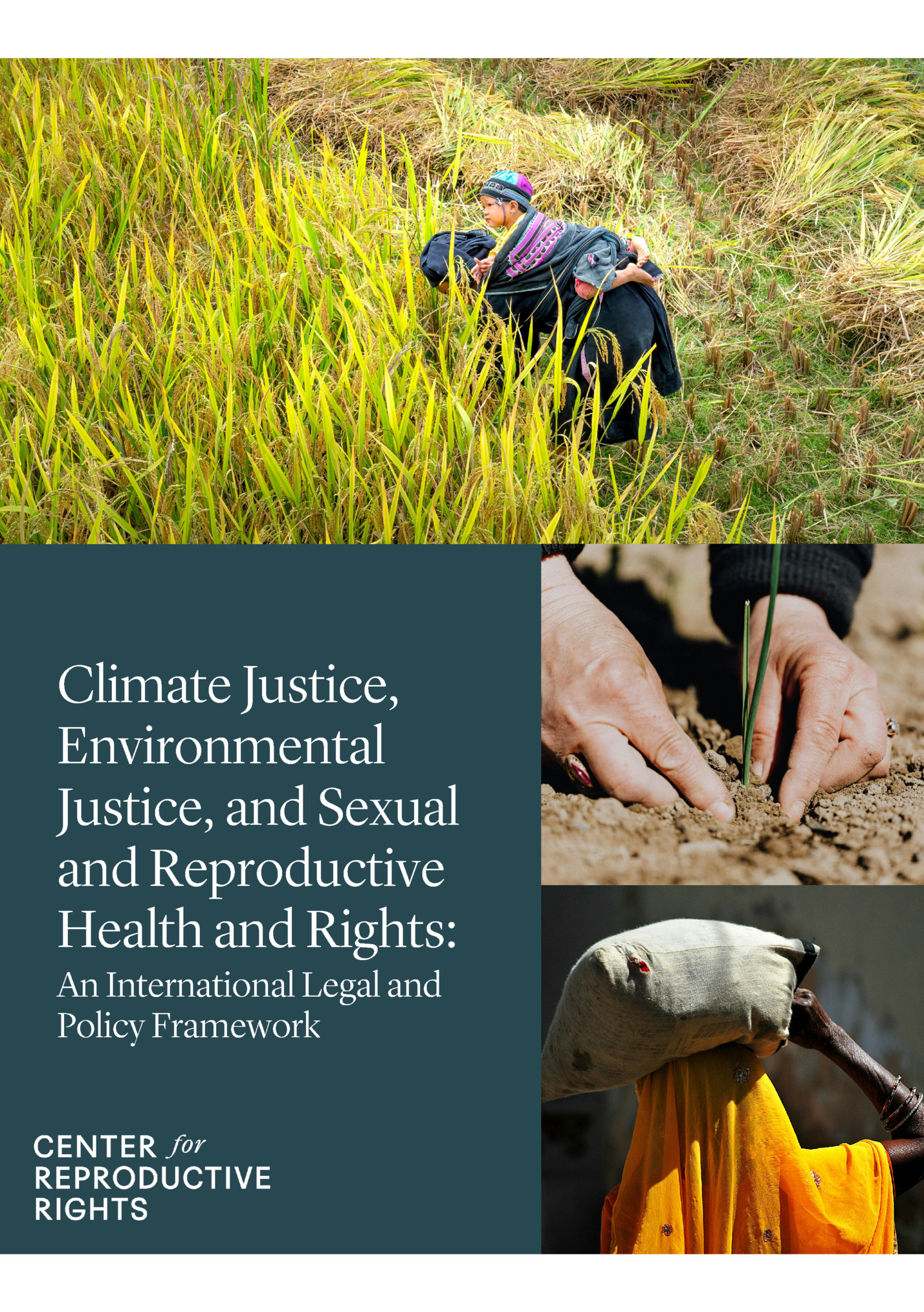
Justice, and SRHR Table of Contents 03 04 06 07 08 16 20 22 23 2 • Center for Reproductive Rights Introduction Legal and policy frameworks International HR frameworks Individual complaints Established HR norms Regional frameworks Areas for future work Conclusion Footnotes
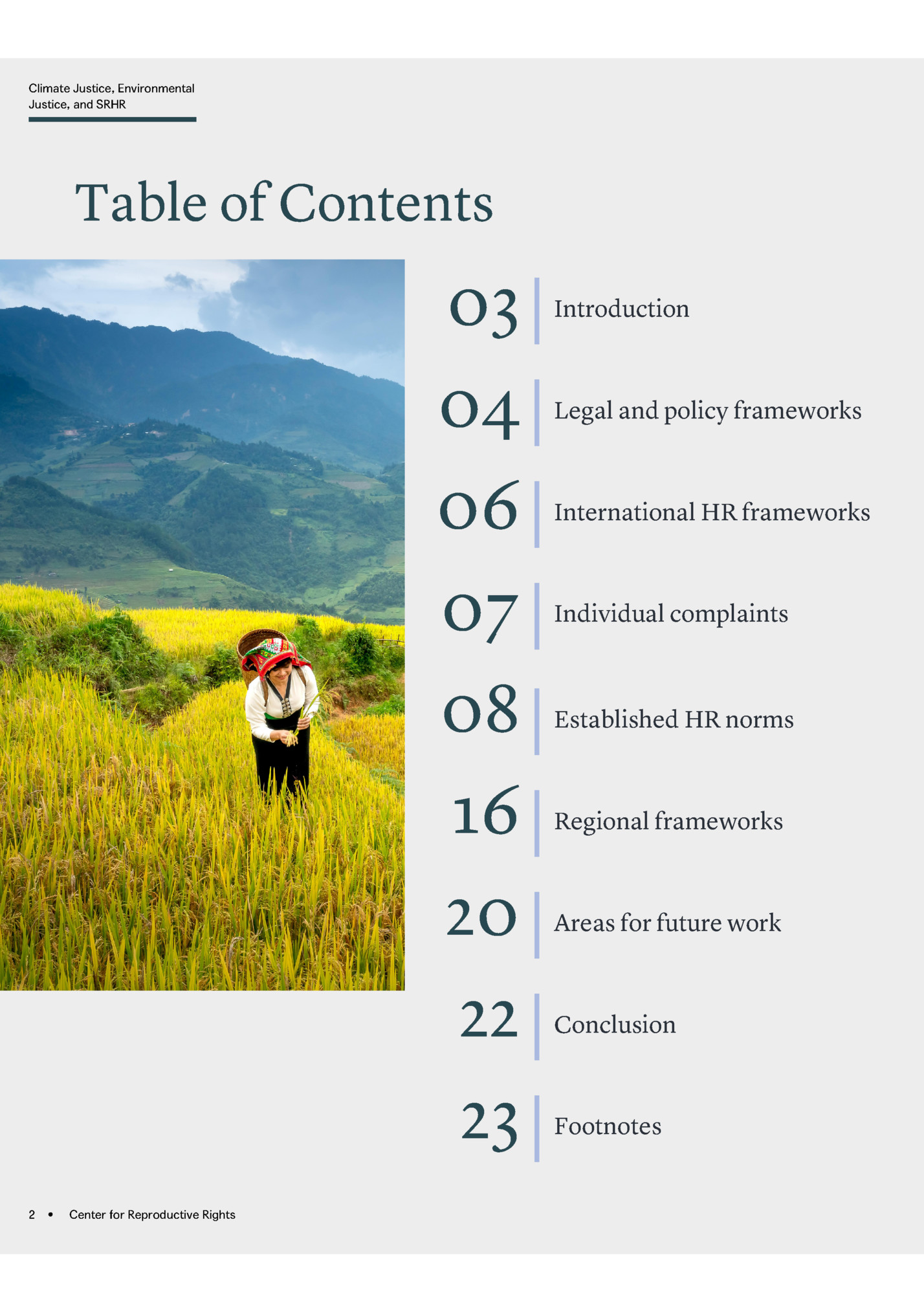
Justice, and SRHR Introduction Climate change(1) and environmental degradation(2) both significantly impact the realization of sexual and reproductive health and rights (SRHR). The exponentially increasing consequences of climate change, including stronger and more frequent natural disasters, sea level rise, extreme temperatures, and shifts in global weather patterns result in forced migration, disrupted supply chains, limitations on resources, and lack of access to health services.(3) These disruptions create and exacerbate barriers to accessing sexual and reproductive health (SRH) services by creating physical barriers to accessing healthcare (e.g., road closures following natural disasters) and limiting access to health providers, supplies, and facilities.(4) In addition, the consequences of climate change create more disaster situations and climate and conflict refugees, while also exacerbating barriers to accessing SRH services in existing humanitarian settings.(5) Separately, environmental degradation impacts SRHR through, for example, exposure to toxic chemicals that are known to cause reproductive harm, with disproportionate impacts on historically marginalized and underserved populations.(6) The international legal and policy framework is a critical tool for addressing, mitigating, and in some cases preventing the adverse SRH consequences of climate change and environmental degradation. As this framework has evolved over the past several decades, it has increasingly recognized that combatting climate change and environmental degradation are human rights imperatives. At the same time, there are also critical opportunities for strengthening the international legal and policy framework to further recognize the detrimental impacts of these issues on SRH and consequently establish greater SRHR protections and guarantees. This factsheet highlights the current protections and guarantees for gender equality and SRHR within international and regional legal and policy frameworks and identifies areas where these norms could be further strengthened. The Center is grateful to Clifford Chance for extensive pro bono support in mapping the current legal and policy framework. Center for Reproductive Rights • 3
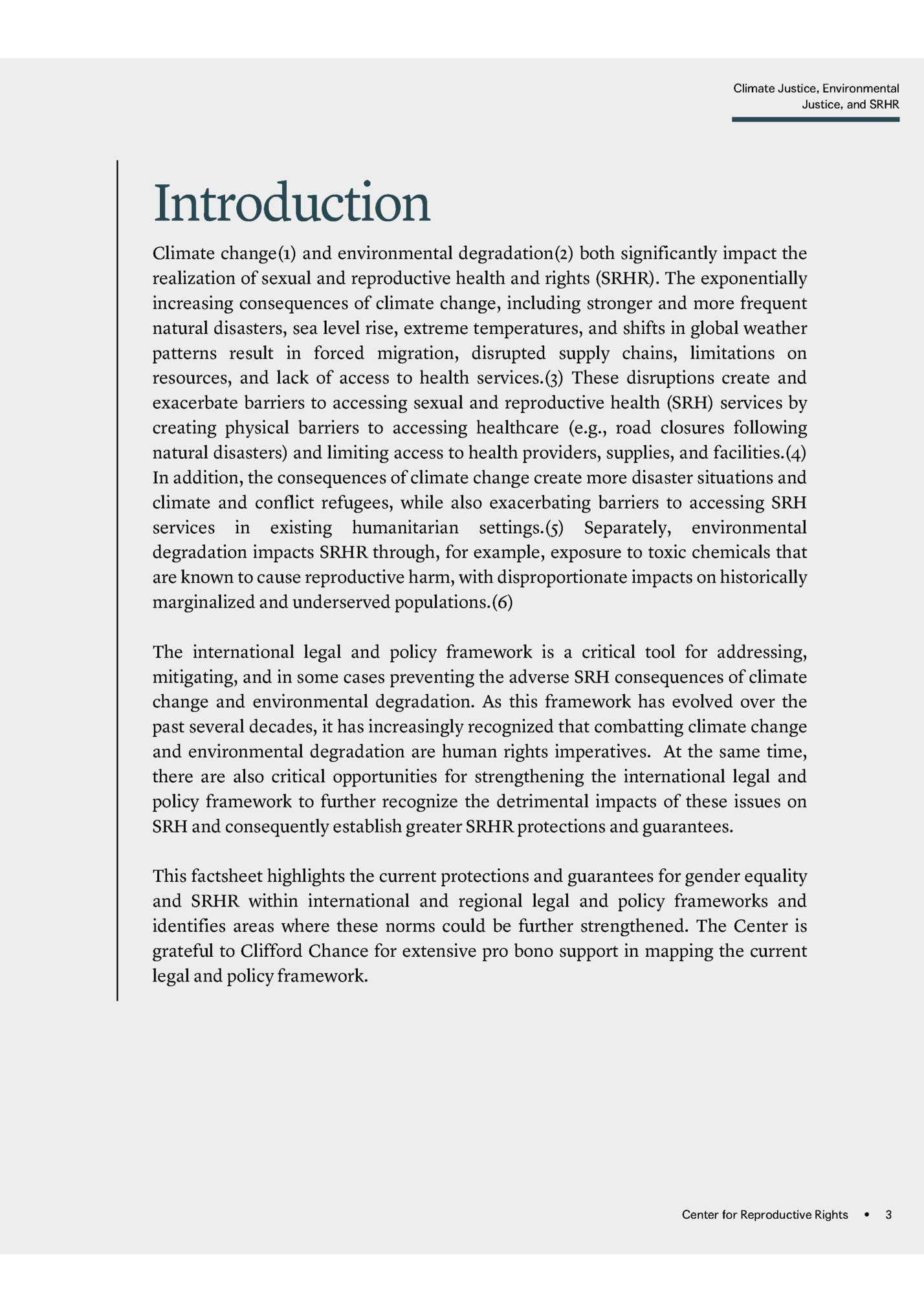
Justice, and SRHR Legal and policy frameworks on climate change There is an immense global legal framework focused broadly on climate change, including the United Nations Framework Convention on Climate Change (UNFCCC)(7), the Kyoto Protocol(8), and the Paris Agreement(9), among many others. This overarching legal framework seeks to mitigate the effects of climate change and develop plans for adaptation and resilience to address the inevitable impacts. However, there is a significant gap in this framework around gender equality, the gendered impacts of climate change and the lack of explicit protections for SRHR.(10) The Paris Agreement remains one of the few international agreements within this framework to recognize the gendered impacts of climate change, recognizing climate change’s effects on gender discrimination and vulnerable and marginalized groups, and noting that all parties should consider gender equality, women’s empowerment, indigenous and local communities, and the right to health when taking actions to address climate change.(11) Although the Paris Agreement discusses human rights considerations states should take into account, explicit recognition of SRHR remains notably absent. 4 • Center for Reproductive Rights
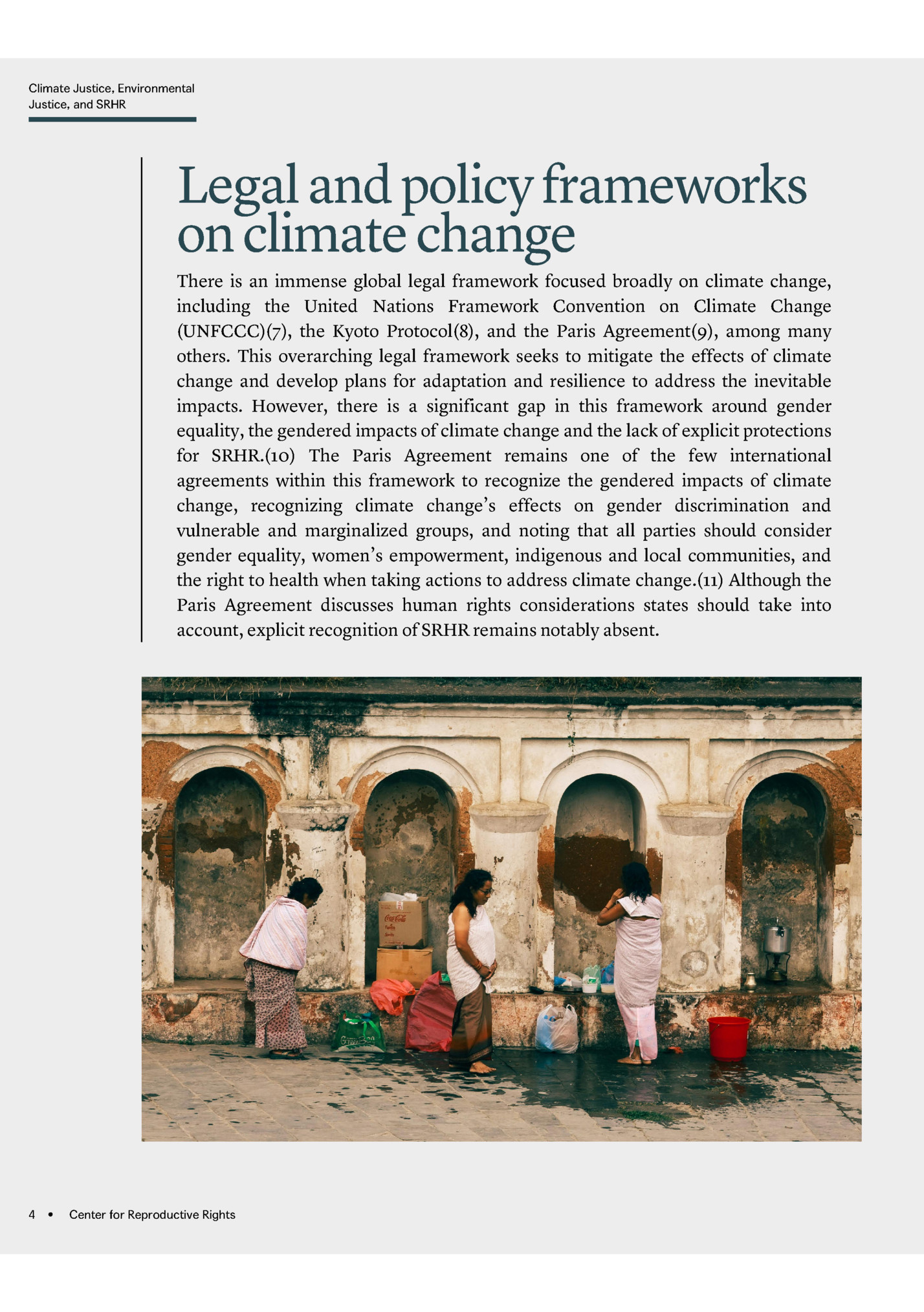
Justice, and SRHR Beyond the larger climate change framework, international bodies are increasingly recognizing the importance of considering gender equality within climate justice discussions and climate change preparedness and response plans. United Nations (UN) political bodies, including the Security Council, the Human Rights Council, and the General Assembly, have adopted important resolutions recognizing the linkages between climate change and gender equality. In 2015, the UN Security Council adopted a resolution on Women, Peace, and Security in which it recognized climate change as a threat to international peace and security, particularly for women around the world.(12) In 2020, the UN Human Rights Council adopted a resolution recognizing women and girls’ human rights in humanitarian settings, including those caused by climate-related events.(13) Then in 2021, the UN Human Rights Council became the first political body at the UN to recognize the right a safe, clean, healthy, and sustainable environment.(14) The resolution recognizes that the impacts of climate change on human rights will be felt most acutely by those segments of the population who are already live in vulnerable situations, including women and girls. Then in July 2022, the UN General Assembly adopted a similar resolution recognizing the right to a clean, healthy, and sustainable environment.(15) UN agencies are beginning to address the impacts of climate change and environmental degradation on human rights and gender equality.(16) In 2015, following negotiations with 162 states, the International Labor Organization adopted the Just Transition Guidelines, a framework to transition countries to environmentally sustainable economies that provide social protections that are adaptable to climate issues.(17) In 2016, the UN Environment Programme recognized the gendered impacts of climate change, including the negative impacts on reproductive health.(18) In 2020, UN Women, the UN Environment Programme, and the UN High Commissioner for Refugees (UNHCR) published a joint report that showcases states’ current human rights obligations around environmental degradation and climate change including the obligation to “[t]ake a gender-responsive approach to ensuring the right to health, including sexual and reproductive health and rights, in environmental action.”(19) Center for Reproductive Rights • 5

Justice, and SRHR An international human rights framework Within the broad legal framework addressing climate change and the environment, human rights bodies have recognized the link between climate justice, humanitarian situations, environmental justice, gender equality, and the right to health.(20) These norms are also beginning to recognize the importance of specifically addressing SRHR within this framework, with the Convention on the Elimination of All Forms of Discrimination Against Women (CEDAW) Committee at the forefront of establishing norms related to climate change and SRHR.(21) As this framework is beginning to evolve to explicitly recognize the impact of these issues on SRHR and establish stronger SRHR protections and guarantees, these norms are becoming increasingly important tools for holding states accountable to protect and guarantee individuals’ access to SRH services during both climate change mitigation and response and climate-related humanitarian response efforts, and to prevent and redress the SRH impacts of environmental degradation. Human rights norms are becoming increasingly important tools for holding states accountable to protect and guarantee individuals’ access to SRH services during climate crises. 6 • Center for Reproductive Rights
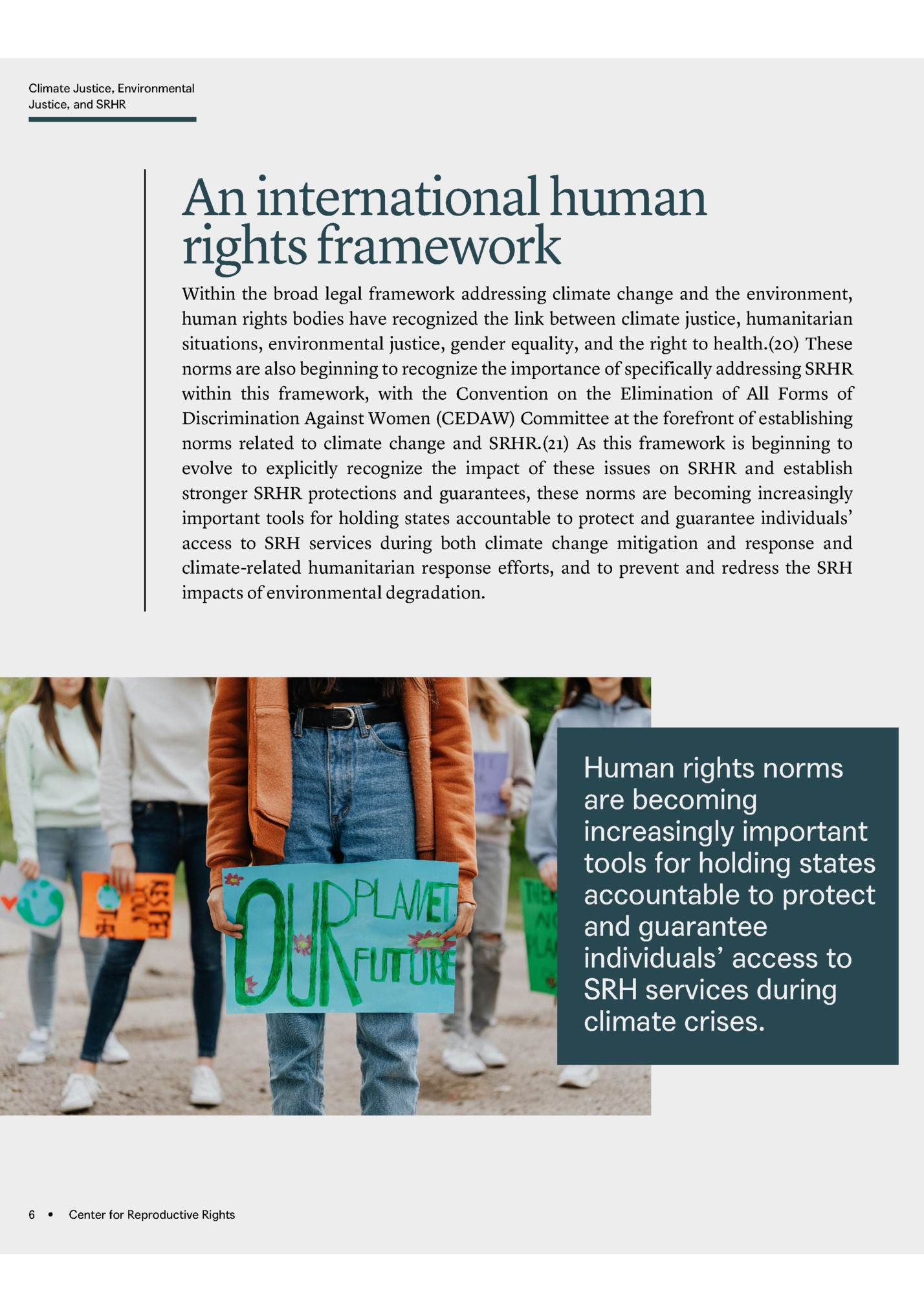
Justice, and SRHR Individual complaints before international bodies Individual complaints before UN Treaty Monitoring Bodies (TMB) or other international accountability bodies have not yet been utilized to create accountability for the SRHR impacts of climate change or environmental degradation. UN human rights bodies have considered three cases related to climate change.(22) Specifically, in 2019, the Committee on the Rights of the Child recognized that failure to reduce greenhouse gas emissions could impair children’s rights under the CRC.(23) Then, in 2020, the Human Rights Committee examined the impact of climate change on asylum-seekers, determining that “countries may not deport individuals who face climate change-induced conditions that violate the right to life.”(24) In 2022, the Human Rights Committee determined that State Parties’ failure to take steps to address climate change can violate their human rights obligations under the International Covenant on Civil and Political Rights (ICCPR).(25) There is an important foundation in the international human rights framework for leveraging international accountability bodies to advance SRHR protections. Such individual complaints have been effective at advancing transformative legal and policy change on SRHR,(26) demonstrating that this could be an important yet untapped avenue for enhancing accountability. Individual complaints could be an important yet untapped avenue for enhancing accountability. Center for Reproductive Rights • 7
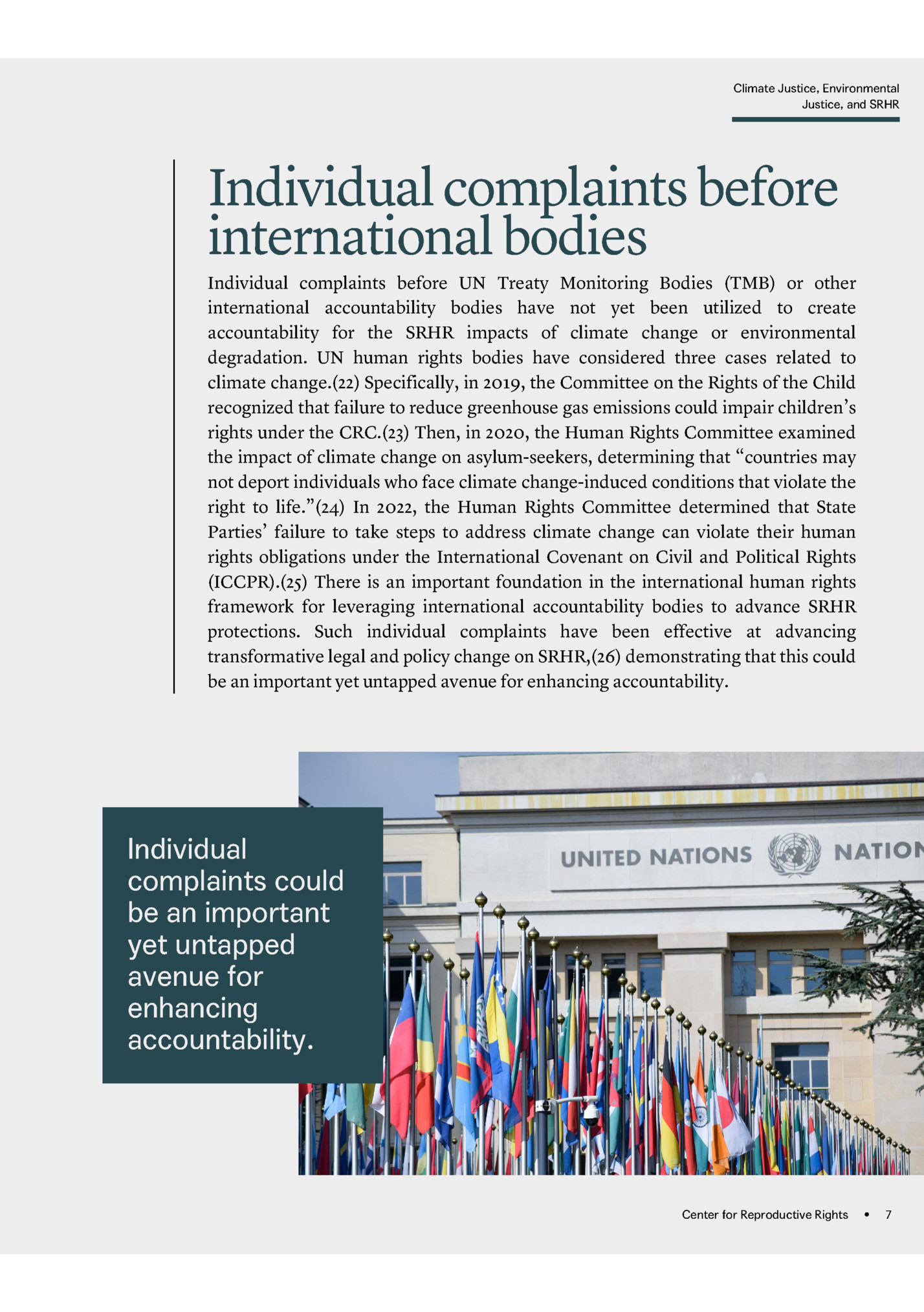
Justice, and SRHR Established human rights norms Climate change disaster response plans must prioritize SRH services. The CEDAW Committee’s General Recommendation No. 37 on Gender-Related Dimensions of Disaster Risk Reduction in the Context of Climate Change was the first general recommendation adopted by a treaty body that is dedicated to addressing climate change.(27) This General Recommendation is the first to explicitly recognize states’ obligations in relation to SRHR in response to climate change.(28) The Recommendation urges states to prioritize SRH services and information, including safe abortion services, contraception, and maternal health care in all disaster-preparedness and response programs.(29) The CEDAW Committee further notes that states should remove all barriers to access SRH services before, during, and after disasters.(30) The CEDAW Committee also asks states to include disaster preparedness and response concepts in health worker trainings, and implement mandatory trainings on women’s health, including the rights of women with disabilities and those belonging to marginalized groups. (31) 8 • Center for Reproductive Rights
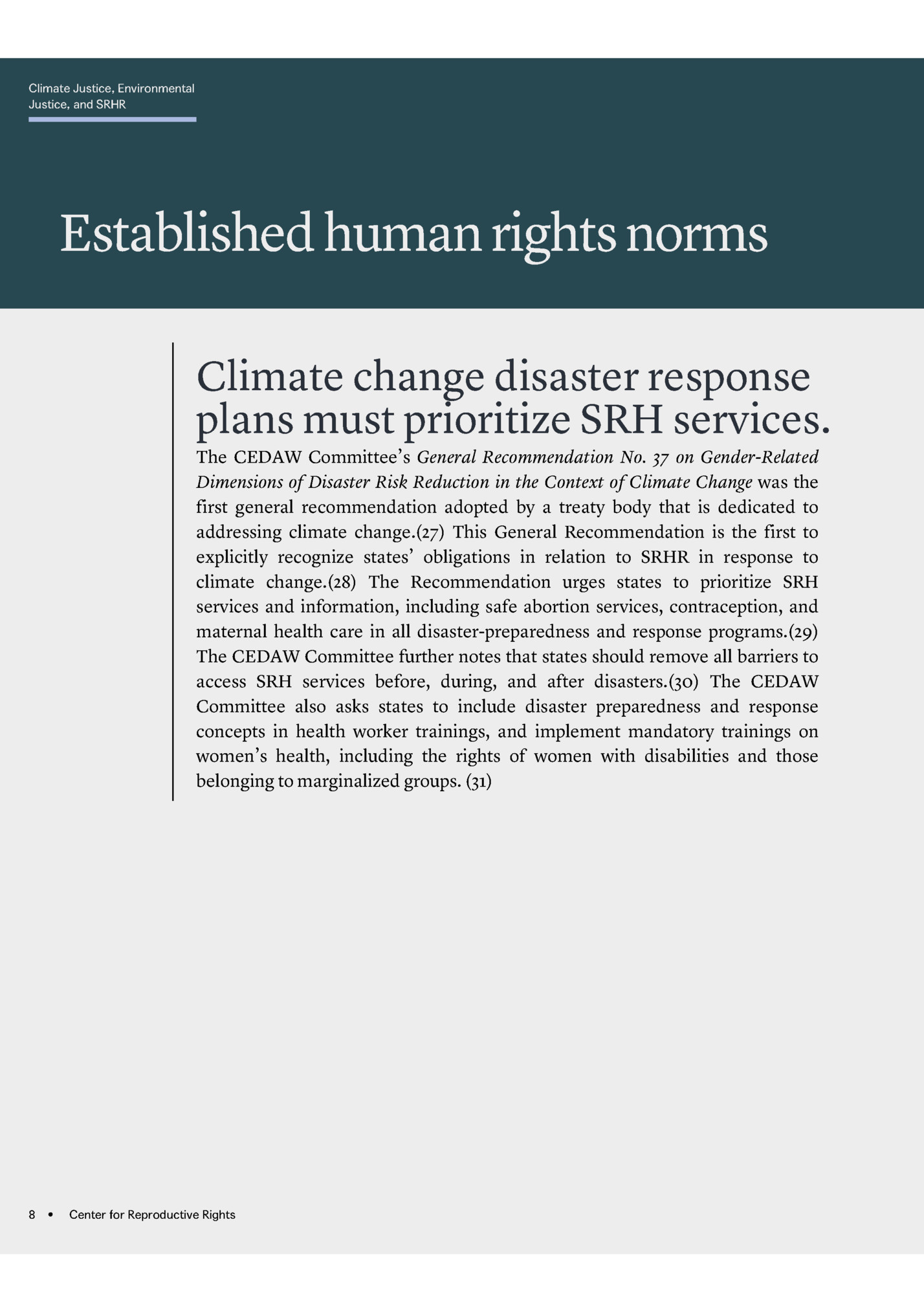
Justice, and SRHR States’ climate change mitigation and adaptation efforts must ensure gender equality and respect, protect, and fulfill women and girls’ rights. Both the Human Rights Committee and the CEDAW Committee have recommended States develop policies that protect vulnerable persons from adverse effects of climate change, especially women and girls who are disproportionately affected by the effects of climate change due to gender discrimination.(32) CEDAW’s General Recommendation No. 37 recognizes the disproportionate impact women and girls face from the climate crisis due to gender discrimination and inequalities.(33) The CEDAW Committee urges states to ensure that women and girls’ human rights are fulfilled in all climate change response and mitigation efforts.(34) In addition, the Human Rights Committee has recognized in concluding observations that climate change and the right to life are inextricably related and that special attention should be drawn to the most vulnerable groups to climate change.(35) The Special Rapporteur on human rights and the environment has also recognized the gendered impacts of environmental degradation, urging states to “[i]ntegrate gender equality into all actions to conserve, protect, restore, use, and equitably share the benefits of nature.”(36) The Special Rapporteur also recognizes climate change as a “risk multiplier that exacerbates other drivers” of environmental degradation.(37) Center for Reproductive Rights • 9

Fleepit Digital © 2021